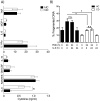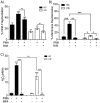Diminished macrophage apoptosis and reactive oxygen species generation after phorbol ester stimulation in Crohn's disease
- PMID: 19907654
- PMCID: PMC2771353
- DOI: 10.1371/journal.pone.0007787
Diminished macrophage apoptosis and reactive oxygen species generation after phorbol ester stimulation in Crohn's disease
Abstract
Background: Crohn's Disease (CD) is a chronic relapsing disorder characterized by granulomatous inflammation of the gastrointestinal tract. Although its pathogenesis is complex, we have recently shown that CD patients have a systemic defect in macrophage function, which results in the defective clearance of bacteria from inflammatory sites.
Methodology/principal findings: Here we have identified a number of additional macrophage defects in CD following diacylglycerol (DAG) homolog phorbol-12-myristate-13-acetate (PMA) activation. We provide evidence for decreased DNA fragmentation, reduced mitochondrial membrane depolarization, impaired reactive oxygen species production, diminished cytochrome c release and increased IL-6 production compared to healthy subjects after PMA exposure. The observed macrophage defects in CD were stimulus-specific, as normal responses were observed following p53 activation and endoplasmic reticulum stress.
Conclusion: These findings add to a growing body of evidence highlighting disordered macrophage function in CD and, given their pivotal role in orchestrating inflammatory responses, defective apoptosis could potentially contribute to the pathogenesis of CD.
Conflict of interest statement
Figures





References
-
- Podolsky DK. Inflammatory bowel disease. N Engl J Med. 2002;347:417–429. - PubMed
-
- Shanahan F. Crohn's disease. Lancet. 2002;359:62–69. - PubMed
-
- Korzenik JR. Past and current theories of etiology of IBD: toothpaste, worms, and refrigerators. J Clin Gastroenterol. 2005;39:S59–S65. - PubMed
-
- Marks DJ, Harbord MW, MacAllister R, Rahman FZ, Young J, et al. Defective acute inflammation in Crohn's disease: a clinical investigation. Lancet. 2006;367:668–678. - PubMed
Publication types
MeSH terms
Substances
Grants and funding
LinkOut - more resources
Full Text Sources
Medical
Research Materials
Miscellaneous

